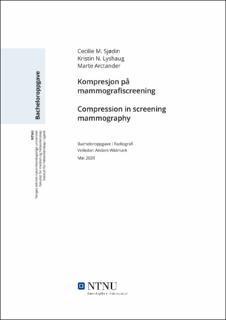| dc.contributor.advisor | Widmark, Anders | |
| dc.contributor.author | Sjødin, Cecilie M. | |
| dc.contributor.author | Lyshaug, Kristin N. | |
| dc.contributor.author | Arctander, Marte | |
| dc.date.accessioned | 2020-07-17T16:03:25Z | |
| dc.date.available | 2020-07-17T16:03:25Z | |
| dc.date.issued | 2020 | |
| dc.identifier.uri | https://hdl.handle.net/11250/2669591 | |
| dc.description.abstract | Problemstilling: Er trykk- eller kraftstandardisert kompresjon mest egnet som kompresjonsmetode med tanke på smerte hos kvinner på mammografiscreening?
Hensikt: Hensikten med oppgaven er å undersøke hvorvidt trykk- eller kraftstandardisert kompresjon er mest egnet som kompresjonsmetode med tanke på smerte hos kvinner på mammografiscreening.
Metode: Oppgaven er en kvalitativ litteraturstudie som inkluderer fire selvstendige artikler.
Resultat: Resultatene er innhentet fra studier som er gjennomført i Norge og Nederland. Gjennomsnittlig smertescore for kraftstandardisert kompresjon var 2,2 og 3,74. Gjennomsnittlig smertescore for trykkstandardisert kompresjon var 2,4 og 4,29 for CC og 4,71 for MLO.
Konklusjon: Resultatene viser at det er variasjoner i gjennomsnittlig smertescore mellom de to kompresjonsmetodene. På bakgrunn av dette kan det i denne oppgaven ikke avgjøres hvilken kompresjonsmetode som er mest egnet på mammografiscreening med tanke på smerte hos kvinner. Vi mener det bør gjøres mer omfattende forskning som tar bakenforliggende faktorer i betraktning ved en evaluering av metodene. | |
| dc.description.abstract | Topic/research question: Is pressure or force standardized compression more suitable as a compression method considering women’s experience of pain in screening mammography?
Purpose: The purpose of the thesis is to investigate whether pressure or force standardized compression is more suitable as a compression method considering women’s experience of pain in screening mammography.
Method: The thesis is a qualitative literature study that includes four independent articles.
Results: The results are obtained from studies conducted in Norway and the Netherlands. The mean pain scores for force-standardized compression was 2.2 and 3.74. Mean pain scores for pressure-standardized compression were 2.4, and 4.29 for CC and 4.71 for MLO.
Conclusion: Based on the results of this thesis there are variations in the mean pain scores between the two compression methods. It is therefore not possible for us to determine which compression method that is more suitable for screening mammography considering women’s experience of pain. We believe that there should be done more extensive research that takes underlying factors into account when evaluating the methods. | |
| dc.publisher | NTNU | |
| dc.title | Kompresjon på mammografiscreening | |
| dc.type | Bachelor thesis | |
